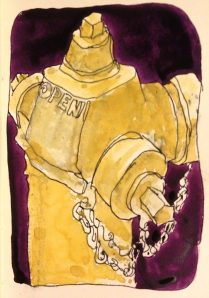Now it’s time for fine tuning. It’s obvious when looking at the original (the scan is a bit skewed) where adjustments need to be made.

Before Fine Tuning, Color Wheel Five
Flexibility and breaking rules is essential for the successful outcome of Color Wheel Five. To create a value of One (Black being a value of Zero) without moving away from the initial color dominance is impossible for segments of yellow, yellow / orange and orange. Example: When neutralizing yellow with purple, so much purple must be added to darken the value of yellow that it can no longer be called a yellow. On the other hand, a Value of Nine ( almost white ) can be created for any hue simply by adding white.
The Purple / Blue also presents problems for me. It’s the left side of my brain that wants to know if Ultramarine Blue is considered a warm blue or a cool blue. I get hung up on labeling the temperature of my pigments rather than simply seeing how they work on the wheel. I’ve had many discussions, some rather heated, regarding Ultramarine Blue. After a bit of surfing on line I found that there is no conclusive truth about the temperature of Ultramarine Blue, nor any other blue for that matter. (Link to WetCanvas discussion of the temperature of blue). I’ve now discarded my need for truth of any kind when it comes to blues. Having done so, I’m released of the need to be concerned about whether to call it warm or cool. All I need to know is where it falls in the spectrum in relationship to all the other blues. Thinking about it this way is easier and far less stressful.
I’ll post Color Wheel Five again when I have adjusted it to my satisfaction.
Color Wheel Five: Mixing neutrals from complementary and near complementary colors in four ranges of values.




